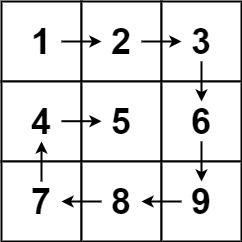螺旋矩阵
给你一个 m 行 n 列的矩阵 matrix ,请按照 顺时针螺旋顺序 ,返回矩阵中的所有元素。
示例 1:

1
2
| 输入:matrix = [[1,2,3],[4,5,6],[7,8,9]]
输出:[1,2,3,6,9,8,7,4,5]
|
示例 2:

1
2
| 输入:matrix = [[1,2,3,4],[5,6,7,8],[9,10,11,12]]
输出:[1,2,3,4,8,12,11,10,9,5,6,7]
|
提示:
m == matrix.lengthn == matrix[i].length1 <= m, n <= 10-100 <= matrix[i][j] <= 100
定义两个数组模拟移动方向
1
2
3
4
5
6
7
8
9
10
11
12
13
14
15
16
17
18
19
20
21
22
23
24
25
26
| class Solution {
public List<Integer> spiralOrder(int[][] matrix) {
int[] dx = new int[] { 0, 1, 0, -1 };
int[] dy = new int[] { 1, 0, -1, 0 };
List<Integer> list = new ArrayList<>();
int d = 0;
int x = 0;
int y = 0;
int m = matrix.length;
int n = matrix[0].length;
for (int i = 0; i < m * n; i++) {
list.add(matrix[x][y]);
matrix[x][y] = 200;
int nextX = x + dx[d];
int nextY = y + dy[d];
if (nextX < 0 || nextY < 0 || nextX >= m || nextY >= n || matrix[nextX][nextY] == 200) {
d = (d + 1) % 4;
nextX = x + dx[d];
nextY = y + dy[d];
}
x = nextX;
y = nextY;
}
return list;
}
}
|

